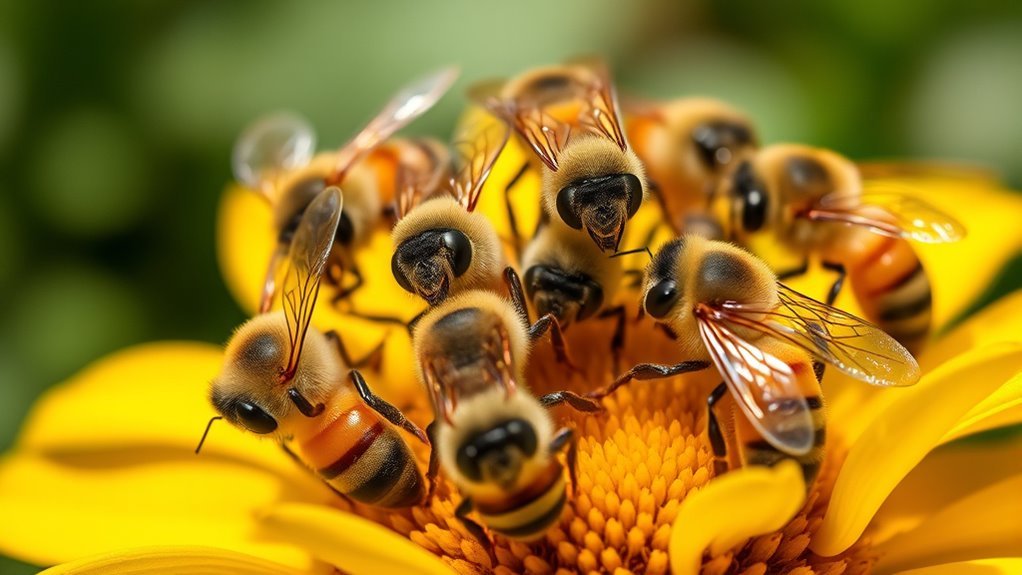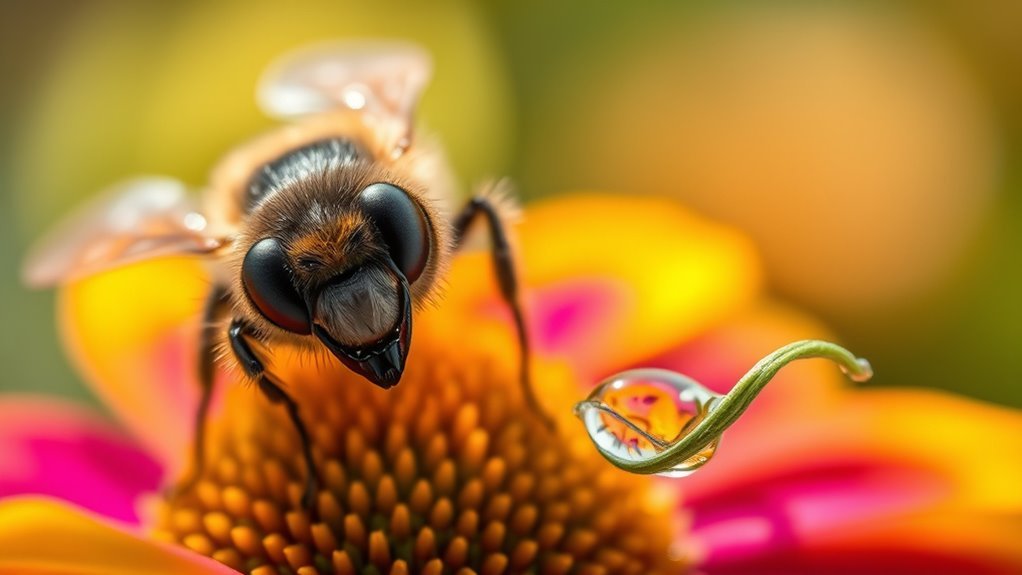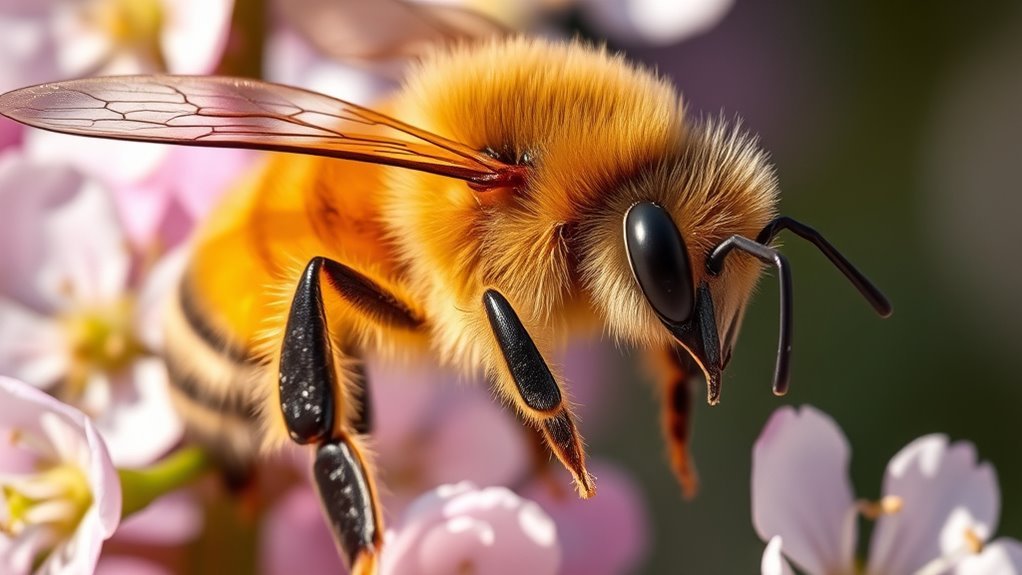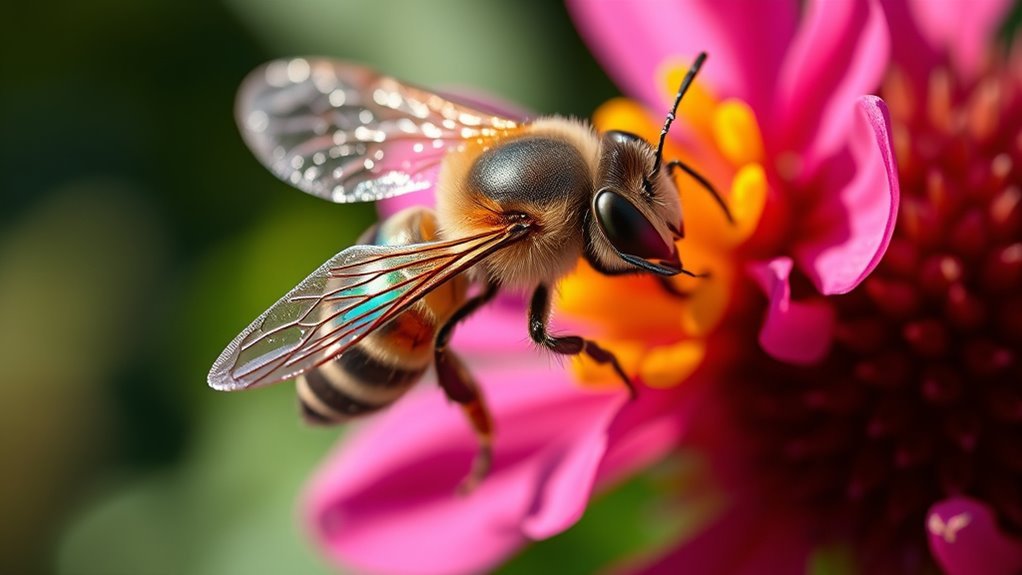Drone bees can’t sting because they lack the stinging apparatus present in worker bees. Their primary focus is mating, which necessitates conserving energy for reproductive success rather than defending the hive. This absence of a stinger allows them to contribute to the colony’s dynamics without the burden of protective behaviors. Understanding the role of drones reveals their importance in maintaining genetic diversity and hive health, providing a deeper insight into their unique contributions to the bee colony.
The Role of Drones in the Bee Colony

Drones play an essential role in the dynamics of a bee colony, primarily focused on reproduction. Their behavior is unique, as they don’t collect nectar or pollen; instead, they exist to mate with a queen during her nuptial flight. This mating process is vital for genetic diversity within the colony, promoting resilience and adaptability. You’ll notice that drone behavior is often passive; they tend to congregate in drone congregation areas, awaiting the queen’s arrival. Their presence influences colony dynamics, as a healthy drone population signals a thriving colony. If drone numbers dwindle, it can indicate potential problems. Understanding these roles helps you appreciate the complexity of bee societies and the balance required for their survival and success.
Anatomy of a Drone Bee

When you examine the anatomy of a drone bee, you’ll notice distinct features that set them apart from worker bees and queens. Significantly, drones lack a stinger, which influences their role within the hive. Understanding these anatomical differences is essential for grasping how drones contribute to the overall function of the colony.
Drone Bee Anatomy
The anatomy of a drone bee reveals specialized structures that distinguish them from other members of the hive. Drones are larger than worker bees and possess unique features tailored for drone mating. Their bodies are built for flight, with powerful wings and a robust musculature to facilitate their drone behavior during mating flights.
| Structure | Function | Distinction from Workers |
|---|---|---|
| Eyes | Large for better vision | Much larger than workers |
| Abdomen | Wider for mating purposes | Rounder and more robust |
| Wings | Strong for long flights | Larger and more muscular |
| Antennae | Sensory functions | More developed for pheromones |
| Reproductive Organs | Specialized for mating | Unique to drones only |
This anatomy is vital for their role in reproduction within the colony.
Lack of Stinger
One notable characteristic of drone bees is their lack of a stinger, setting them apart from worker bees. This absence stems from their unique stinger development, which doesn’t occur as it does in females. Instead of evolving to defend the hive, drone bees have adapted to fulfill different roles. The evolutionary advantages of not having a stinger include conserving energy for mating flights and focusing on reproductive success rather than hive protection. This specialization allows drones to contribute to the hive’s genetic diversity without the burden of defending it. By not having a stinger, drone bees embody a distinct evolutionary path that aligns with their primary function: ensuring the continuation of the colony through reproduction.
Role in Hive
Without a stinger, drone bees take on a distinct role within the hive, primarily centered around reproduction. Their presence is essential for maintaining hive dynamics, as they’re tasked with mating with the queen. This unique drone behavior is crucial for genetic diversity, guaranteeing the survival of the colony.
| Drone Function | Impact on Hive Dynamics |
|---|---|
| Mating | Guarantees genetic diversity |
| Nutrient Needs | Balances resource allocation |
| Seasonal Role | Influences hive population |
As you can see, drones may lack a stinger, but their contributions are invaluable. They embody a specific freedom within the hive, allowing the colony to thrive and adapt in a world full of challenges.
Stinging Mechanism in Bees

In understanding the stinging mechanism of bees, you’ll find that the anatomy of bee stingers plays a vital role. While drone bees are typically non-stingers, their presence is essential in the hive’s defense strategy, particularly in relation to the queen. This highlights the interplay between the stinging capabilities of worker bees and the protective measures that maintain the hive’s safety.
Anatomy of Bee Stingers
The stinger of a bee is a complex biological tool designed for defense and protection. Its evolution reflects a remarkable adaptation, enabling bees to ward off threats while guaranteeing their survival. The anatomy of the stinger consists of several parts that work in unison.
| Component | Function | Importance |
|---|---|---|
| Shaft | Penetrates the skin | Delivers venom |
| Barbs | Anchors the stinger | Secures retention |
| Venom sac | Stores venom | Causes pain and deterrence |
| Nerve endings | Triggers pain response | Warns of danger |
Understanding the stinger’s structure allows you to appreciate how bees utilize this mechanism for effective bee defense. These adaptations are vital for their survival in a world full of predators.
Role of Drone Bees
While understanding the anatomy of bee stingers reveals how worker bees defend their colonies, it’s important to recognize that drone bees play a different role in the hive. Unlike their worker counterparts, drones don’t possess stingers, which directly influences their behavior and purpose. Their primary function revolves around mating habits; they’re developed solely for reproduction. During the mating season, drones exhibit specific behaviors, such as flying to drone congregation areas where they seek out queens. This focus on mating rather than defense allows drones to conserve energy, ensuring they’re ready for their critical role in the hive’s genetic diversity. By understanding these aspects of drone behavior, you can appreciate the unique contributions they make to the colony.
Queen’s Defense Mechanism
Although often overshadowed by the more commonly known worker bees, the queen bee’s stinging mechanism is essential for the colony’s defense. Unlike workers, the queen’s stinger is primarily used for queen protection rather than aggressive defense. Her stinger can inflict pain on rivals, maintaining her dominance in the hive hierarchy. When threatened, she may use her stinger to deter intruders, ensuring the safety of her brood and the entire colony. This behavior reflects her unique role, as her survival directly impacts the hive’s stability. While worker bees tirelessly defend the hive, the queen’s ability to sting reinforces her authority and protects the genetic future of the colony. Understanding this mechanism highlights the complexities of bee society and their intricate social structure.
Differences Between Drones and Worker Bees
Honeybee colonies consist of three primary castes: the queen, drones, and worker bees, each serving distinct roles essential to the hive’s survival. Understanding the differences between drones and worker bees reveals fascinating insights into hive dynamics and drone behavior.
Honeybee colonies feature a queen, drones, and worker bees, each playing vital roles for the hive’s survival.
- Physical Attributes: Drones are larger, with robust bodies and no stingers, while worker bees are smaller, equipped with stingers for defense.
- Roles: Drones primarily focus on mating, whereas worker bees perform tasks like foraging, nursing, and hive maintenance.
- Lifespan: Drones have a shorter lifespan, often dying after mating, whereas worker bees can live several weeks to months.
These distinctions illustrate how each caste contributes uniquely to the colony’s overall health and function, emphasizing the intricate balance within bee societies.
The Purpose of Drone Bees
Drone bees play an essential role in the reproductive cycle of honeybee colonies. Unlike worker bees, drones are specifically designed for mating, exhibiting unique drone behavior during the hive’s reproductive period. Their primary purpose is to mate with a queen, ensuring genetic diversity within the colony. During mating rituals, drones gather in specific areas known as drone congregation areas, where they wait for a queen to arrive. This behavior is significant; it allows for successful mating, which is critical for the colony’s survival and growth. While drones may seem less active in daily hive duties, their role is indispensable in maintaining the colony’s health and ensuring future generations thrive. Understanding this purpose highlights the interconnectedness of hive dynamics.
Reproductive Functions of Drones
While it’s easy to overlook their significance, the reproductive functions of drones are crucial to the success of the honeybee colony. During the reproductive season, drones play a pivotal role in ensuring the continuation of their species through drone mating. Here are three key aspects of their reproductive functions:
The reproductive roles of drones are vital for the honeybee colony’s survival and genetic diversity.
- Mating Flights: Drones leave the hive to join mating flights, where they aim to mate with a queen.
- Genetic Diversity: By mating with multiple queens, drones contribute to the genetic diversity necessary for a resilient colony.
- Lifecycle Timing: Drones are produced in response to specific environmental cues, ensuring they’re available during peak reproductive times.
Understanding these functions helps you appreciate the crucial role drones play in honeybee reproduction and colony health.
How Drones Contribute to Hive Survival
Though often overshadowed by worker bees, drones play an irreplaceable role in the survival of the hive. Their primary function, mating with the queen, guarantees genetic diversity, essential for resilience against diseases and environmental changes. Without drones, the hive’s genetic pool would stagnate, weakening its overall health. Furthermore, drone behavior influences hive dynamics; their presence encourages worker bees to maintain a balanced environment. This balance is significant, as it helps regulate temperature and humidity levels within the hive. Drones also assist in foraging behavior, albeit indirectly, by stimulating worker bees to venture out more confidently. Ultimately, the contribution of drones is fundamental not just for reproduction but for sustaining a stable and thriving colony.
Myths and Misconceptions About Drones
Many people hold misconceptions about drones, often viewing them as mere bystanders in the hive. These drone myths can lead to a skewed understanding of their role. Here are three common bee misconceptions you should know:
- Drones are lazy: In truth, they play an essential role in mating, ensuring the continuation of the colony.
- Drones don’t contribute to foraging: While they don’t gather nectar, they help maintain hive harmony and support worker bees.
- All drones are expendable: Drones may seem less important, but their genetic diversity is critical for a healthy hive.
The Ecological Importance of Drone Bees
Understanding the ecological importance of drone bees reveals their essential contributions beyond mating. While they primarily exist to mate with queens, their presence markedly impacts the hive’s overall health. By fostering genetic diversity within the bee population, drone bees enhance resilience against diseases and environmental changes. This genetic variation is critical for maintaining robust ecosystems.
| Contribution | Description |
|---|---|
| Genetic Diversity | Promotes healthier bee populations |
| Mating with Queens | Guarantees reproduction and hive stability |
| Pollination Impact | Aids in the pollination of various plants |
| Hive Dynamics | Supports social structure within hives |
| Ecosystem Health | Contributes to biodiversity and food sources |
Ultimately, drone bees play an understated yet essential role in sustaining ecological balance.
Frequently Asked Questions
Can Drone Bees Defend the Hive Like Worker Bees?
You might observe a hive where worker bees defend fiercely, while drones, focused on mating, don’t engage in defense. Their unique drone behavior affects hive dynamics, highlighting their reproductive role rather than protective functions.
How Many Drones Are Typically in a Bee Colony?
In a typical bee colony, there’re about 100 to 300 drones. Their lifecycle plays an essential role in hive dynamics, as they primarily exist to mate with queens, ensuring genetic diversity and colony survival.
Do Drone Bees Ever Leave the Hive?
Imagine a lone wanderer; drone bees do leave the hive, yet their journeys are driven by drone behavior linked to hive dynamics. They seek mates, embracing freedom for a brief moment before returning to their colony.
What Happens to Drones After Mating?
After the mating process, drones typically die shortly after mating, marking the end of their lifecycle. This brief existence serves an essential purpose in ensuring the queen’s reproduction, ultimately supporting the hive’s survival and continuity.
Are Drone Bees Larger Than Worker Bees?
You might think drone bees are giants of the hive, but their size is merely a bit larger than worker bees. Their unique bee anatomy, designed for reproduction, emphasizes function over size in the colony.

